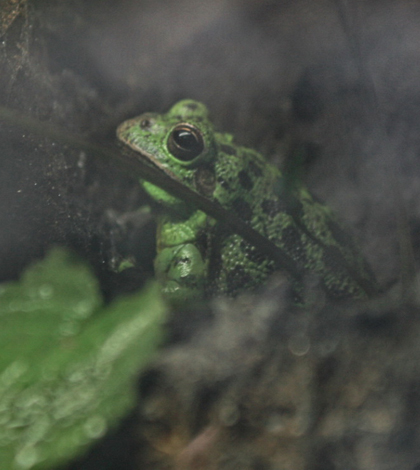Recorded tree frog calls could signal wetlands restoration progress in Everglades plan

The Barking tree frog was one of the speices only found calling in the study's relatively natural reference sites. (Credit: Cliff, via Flickr)
The recorded croaks of a few tree frog species could help habitat restoration managers know when their work on degraded wetlands is done, according to a new study.
The study, published in the journal Wetlands Ecology and Management, analyzed automated recordings of calling frogs in and around the Picayune Strand State Forest in southern Florida, the site of a sprawling failed development project that cleared the land of natural wetland habitats.
The researchers compared recordings made in sites undergoing restoration with others from nearby locations that were in good enough shape to serve as reference sites.
“They certainly weren’t pristine,” said Susan Walls a research wildlife biologist with the U.S. Geological Survey and lead author of the study. “But they were relatively less disturbed. Lets put it that way.”
The Picayune Strand was once covered in cypress, pines and wet prairies. During a typical summer wet season, rainfall drained southward in sheet of water that periodically flooded uplands. That created temporary fishless ponds that sensitive species like the barking tree frog depend on for reproduction. Logging, along with road and canal building, disrupted the landscape from the ’40s to the ’60s.
Today the Picayune Strand Restoration Project — part of the Comprehensive Everglades Restoration Plan — is in the midst of removing roads, plugging canals and recreating wetlands. The project has already seen some progress, but Walls said it isn’t clear what target a completed project looks like. “There were no goalposts established prior to the restoration,” she said.
Working under the idea that less disturbed systems should support a greater diversity of amphibian species, the scientists set up Song Meter automated recording units in restoration and reference sites. The recorders captured five minutes of sound at the beginning of every hour throughout the night and early morning.
[youtube id=”mvhcDpx7Qvk” width=”620″ height=”360″]
After recording throughout the spring and summer of 2010 and 2011, the researchers were left with an ocean of audio to wade through. Since frogs call more intensely after rain events, the team used rainfall data from nearby weather stations to target the days following storms. By playing through the remaining files and identifying species based on calls, the researchers documented which species were present in each site.
A total of 14 species were identified overall, all of which were present in the reference sites, but only eight to 13 were found in the restoration sites, depending on the location. To Walls, that was a huge difference that shows that the species richness of the reference sites is a good restoration target.
Two species of note that appeared in the reference sites but not the restoration sites were the barking tree frog and pinewoods tree frog. Neither are listed as threatened or endangered, but they both have particular habitat requirements that apparently weren’t met by the restoration sites.
“That’s really what was driving the research, was to find areas where those two species in particular occurred,” Walls said. “They’re really interesting frogs that — if you’re going to have a nice, healthy, stable community of amphibians — you would want those communities to include.”
[youtube id=”FJ1-xkJXYQw” width=”620″ height=”360″]
Top image: The Barking tree frog was one of the species only found calling in the study’s relatively natural reference sites. (Credit: Cliff, via Flickr)




0 comments